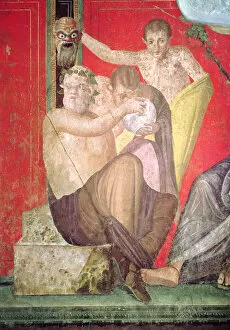Second Pompeiian Style Collection
The "Second Pompeiian Style" is a captivating artistic movement that takes us back to the ancient world, specifically the initiation rites of the cult of Dionysus
All Professionally Made to Order for Quick Shipping
The "Second Pompeiian Style" is a captivating artistic movement that takes us back to the ancient world, specifically the initiation rites of the cult of Dionysus. One remarkable depiction can be found in the fresco from the Villa Dei Mysteri, transporting us to a time when these rituals were shrouded in mystery and intrigue. As we delve into this mesmerizing artwork, we are greeted by an array of vibrant colors and intricate details. The frescoes from the Villa Dei Mysteri, dating back to the 1st century BC, offer us a glimpse into these sacred ceremonies. They serve as visual narratives that unravel before our eyes. In one scene, we witness women comforting initiates during their transformative journey. Their compassionate presence provides solace amidst what must have been an overwhelming experience for those undergoing initiation. This portrayal on the South Wall of Oecus 5 captures both vulnerability and strength. Adjacent to it lies another captivating image: Silenus and the Young Satyr on the East Wall of Oecus 5. Here, we see playful figures embodying joyous revelry associated with Dionysian worship. Their lively gestures invite us to partake in their ecstatic dance as they celebrate life's pleasures. Moving along, an attendant pours liquid from a jug on the North Wall of Oecus 5—a symbolic act representing purification or perhaps even communion with divine forces. Such rituals were integral parts of Dionysian worship and highlight its spiritual significance within ancient society. Further exploration reveals fascinating Egyptian-style paintings adorning a tablinium—birds feasting on nuts—an unexpected fusion between cultures that showcases Pompeii's cosmopolitan nature during this period. Amongst all these scenes stands out one particular detail—the head of Seated Mother from Catechism Scene on North Wall—exuding maternal warmth and protection over those embarking upon this mystical path towards enlightenment.












